Rain or shine, Mark Rachal, Florida Coastal Islands Sanctuaries Manager, and Jeff Liechty, Coastal Biologist, have a unique commute to work: straight to Hillsborough Bay, tucked into the northeast section of Tampa Bay.
They arrive at the boat launch by 9 a.m. (if the weather cooperates), packing water, coffee, a cooler for lunch and snacks, as well as binoculars, camera, and field notebook. Then it’s out to the dozens of islands that make up the Audubon Florida Coastal Islands Sanctuaries.
Protected by Audubon since 1934, these islands are home to some of the Sunshine State’s most iconic – and threatened – bird species, including the Reddish Egret, Roseate Spoonbill, American Oystercatcher, and more. In fact, 10,000 pairs of 16 different species feed, raise their young, and rest here.
Mark and Jeff continue this legacy of protection.
“Usually I am surveying,” Liechty explains. “Counting nesting or non-breeding sea, shore, and wading birds. I also work with partners on management activities – posting signs, removing fishing line or other trash, working on habitat restoration projects.”
In addition to monitoring the nesting efforts of coastal birds, Rachal and Liechty lead the Audubon Florida team’s natural infrastructure work in the Tampa Bay region, working to build, monitor, and expand living shorelines to protect critical nesting islands from erosion. These living shorelines have become a model for how to utilize nature to protect not only our coastline, but our coastal communities too. Read more here.

Because they spend so much of their time on the water, each day presents an opportunity to see something new, from a rare bird species to the first of the migrating birds returning to Florida in the spring.
“Being on the water allows us to not only keep an eye on our nesting birds, but also connect with the recreational boaters that use the bay for fishing, bird watching, photography and so much more,” Rachal explains. “We work closely with folks to ensure we can enjoy all Tampa Bay has to offer while protecting vulnerable birds.”
In addition to working with boaters and anglers, Florida Coastal Islands Sanctuaries partners with local, state, and federal entities to protect these iconic species and their habitat.
“We shouldn't take Tampa Bay's birds for granted,” Liechty continues. “From common birds like White Ibis that forage in our neighborhoods to rare and threatened birds like Reddish Egrets, they all require quality foraging and nesting habitat.”
He adds: “These birds have faced so many human impacts over the past century, including the wading bird populations crashing from hunting during the plume trade, to pelicans devastated by DDT, to today's threats of development, sea level rise, and disturbance from our ever-growing population. The future of these iconic birds is in our hands.”
Audubon directly engages the local community in bird conservation. Project ColonyWatch encourages volunteer birders to adopt and protect local bird colonies. To date, volunteers from Sarasota, St. Petersburg, Tampa, Venice Area, Indian River, Apalachee, Kissimmee Valley, Manatee County, and Citrus County Audubon Societies have participated in Project ColonyWatch, with important and significant wildlife protection results. Want to get involved? Click here!
The mission of the Florida Coastal Islands Sanctuaries is the protection of the great colonial waterbird populations of the Florida Gulf coast, and the natural systems that support them.






